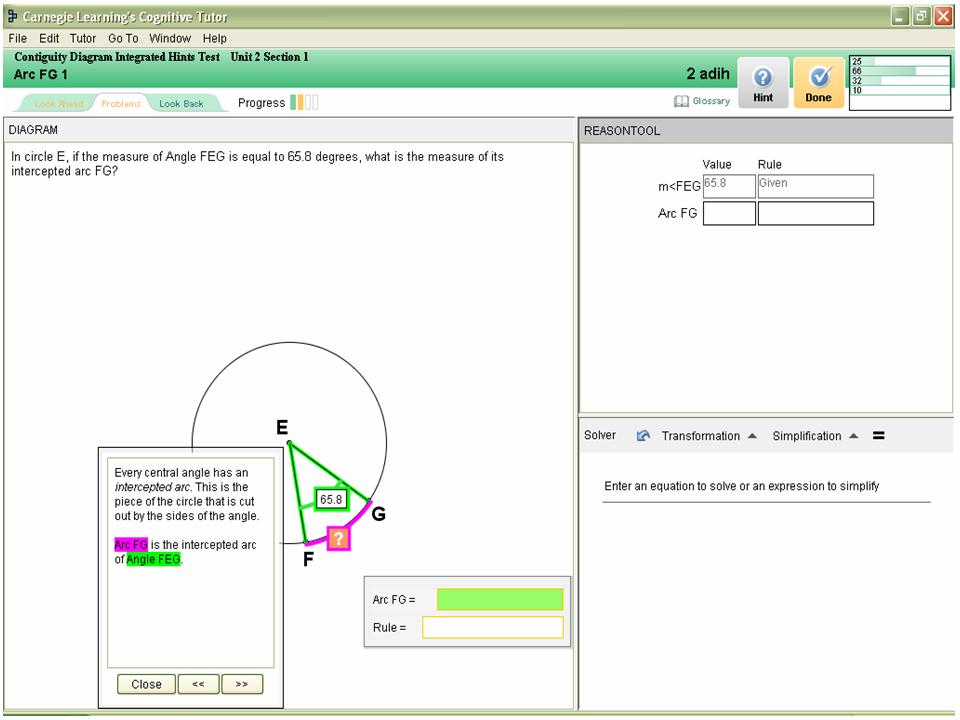Mapping Visual and Verbal Information: Integrated Hints in Geometry (Aleven & Butcher)
Contents
Using Elaborated Explanations to Support Geometry Learning
Vincent Aleven and Kirsten Butcher
Summary Table
| PIs | Vincent Aleven & Kirsten R. Butcher |
| Other Contributers | Graduate Students: Carl Angioli (CMU HCII), Michael Nugent (Pitt, Computer Science) Research Programmers/Associates: Octav Popescu (Research Programmer, CMU HCII), Grace Lee Leonard (Research Associate, CMU HCII), Thomas Bolster (Research Associate, CMU HCII) |
| Study Start Date | Planned Start: April 24, 2007 |
| Study End Date | Expected End: June 1, 2007 |
| LearnLab Site | Central Westmoreland Career & Technology Center (CWCTC) |
| LearnLab Course | Geometry |
| Number of Students | Expected: 120 |
| Total Participant Hours | Expected: 480 |
| DataShop | (Study not yet completed. Log data will be provided to the DataShop when available) |
Abstract
Does integration of visual and verbal knowledge during learning support deep understanding? Can robust learning be supported implicitly by representations that link relevant knowledge components in visual and verbal materials? The overall goal of this project is to gain a better understanding of 1) visual and verbal knowledge components in a problem-solving environment and, 2) how instructional support to promote connections between visual and verbal knowledge components can support the development of deep understanding. Ultimately, we are interested in coordination and integration processes in learning with visual and verbal knowledge components, and how these processes may support robust learning.
We are using the Geometry Cognitive Tutor as a research vehicle for our project. In geometry, visual information is represented pictorially in a problem diagram and verbal/symbolic information is represented in text that contains given and goal information as well as in conceptual rules/principles of geometry. The goal of the research described here is to determine if implicit instructional events that use visual cues to map between text and diagrams can support knowledge retention and transfer. In this research, colored highlighting is used to connect textual references to geometric elements (in instructional hints) to the visual depictions of those features in the geometry diagram (screen shots provided below, in the Independent Variables section).
Background & Significance
Placeholder
Glossary
See Visual-Verbal Learning Project Glossary
Research questions
Placeholder
Independent Variables
Dependent variables
- Pretest, normal post-test, and transfer test measuring student performance on:
- Log data collected during tutor use, used to assess:
- Learning curves
- Time on task
- Error rates
- Latency of responses
Hypothesis
- Placeholder
Findings (Anticipated)
- Study Summary
Placeholder
Explanation
Placeholder
Further Information
Connections
Interactive Communication as Support for Visual-Verbal Integration:
Our research is investigating multiple methods with which student learning can be supported by interactions with pictorial information during geometry learning. Our work also includes more a more explicit method for supporting student integration visual and verbal knowledge components. This method involves interactive support for students' elaborated explanations during geometry learning. Research investigating this explicit support is part of the Interactive Communication Cluster: LINK
Annotated Bibliography
- Poster from PSLC Advisory Board visit, Fall 2005
- Presentation to NSF Site Visitors, Spring 2006
- Presentation to the PSLC Advisory Board, Fall 2006 Link to Powerpoint slides
References
Placeholder
Future Plans: June 2007 - December 2007
- (Carnegie Learning): Anonymize log data and assessments, then provide to DataShop
- Analyze log data and learning outcomes
- Prepare manuscript
- Prepare final project report for PSLC
